Phase Evolution, Filler-Matrix Interactions, and Piezoelectric Properties in Lead Zirconate Titanate (PZT)-Filled Polymer-Derived Ceramics (PDCs)
Abstract
1. Introduction
2. Materials and Methods
2.1. Sample Preparation
2.2. Metallization and Polarization of the Samples
2.3. Sample Characterization
3. Results and Discussion
3.1. Microstructure Evolution in PZT-Polymer and PZT-PDC Composites
3.2. Phase Evolution in PZT-Polymer and PZT-PDC Composites
3.3. Mechanical and Thermal Properties of PZT-Polymer Composites
3.4. Piezoelectric Properties of PZT-Polymer Composites
4. Conclusions
Supplementary Materials
Author Contributions
Funding
Acknowledgments
Conflicts of Interest
References
- Babu, I.; van den Ende, D.A.; de With, G. Processing and characterization of piezoelectric 0-3 PZT/LCT/PA composites. J. Phys. D Appl. Phys. 2010, 43, 425402. [Google Scholar] [CrossRef]
- Salmang, H.; Scholze, H.; Telle, R. Keramik, 7th ed.; Springer: Berlin/Heidelberg, Germany, 2007. [Google Scholar]
- Jaffe, B.; Cook, W.R.; Jaffe, H. Piezoelectric Ceramics; Academic Pr: London, UK, 1971. [Google Scholar]
- Seifert, K.; Schlegel, T.; Rödel, J. Entwicklung neuer oxidischer Piezowerkstoffe. Thema Forschung 2006, 10–13. [Google Scholar]
- Newnham, R.E.; Skinner, D.P.; Cross, L.E. Connectivity and piezoelectric-pyroelectric composites. Mater. Res. Bull. 1978, 13, 525–536. [Google Scholar] [CrossRef]
- Konegger, T.; Potzmann, R.; Puchberger, M.; Liersch, A. Matrix–filler interactions in polysilazane-derived ceramics with Al2O3 and ZrO2 fillers. J. Eur. Ceram. Soc. 2011, 31, 3021–3031. [Google Scholar] [CrossRef]
- Sharma, S.K.; Gaur, H.; Kulkarni, M.; Patil, G.; Bhattacharya, B.; Sharma, A. PZT–PDMS composite for active damping of vibrations. Compos. Sci. Technol. 2013, 77, 42–51. [Google Scholar] [CrossRef]
- Babu, I.; Hendrix, M.M.R.M.; de With, G. PZT-5A4/PA and PZT-5A4/PDMS piezoelectric composite bimorphs. Smart Mater. Struct. 2014, 23, 25029. [Google Scholar] [CrossRef]
- Bhimasankaram, T.; Suryanarayana, S.; Prasad, G. Piezoelectric polymer composite materials. Curr. Sci. 1998, 74, 967–976. [Google Scholar]
- Yamada, T.; Ueda, T.; Kitayama, T. Piezoelectricity of a high-content lead zirconate titanate/polymer composite. J. Appl. Phys. 1982, 53, 4328–4332. [Google Scholar] [CrossRef]
- Jayasundere, N.; Smith, B.V. Dielectric constant for binary piezoelectric 0-3 composites. J. Appl. Phys. 1993, 73, 2462–2466. [Google Scholar] [CrossRef]
- Satish, B.; Sridevi, K.; Vijaya, M.S. Study of piezoelectric and dielectric properties of ferroelectric PZT-polymer composites prepared by hot-press technique. J. Phys. D Appl. Phys. 2002, 35, 2048–2050. [Google Scholar] [CrossRef]
- Babu, I.; de With, G. Highly flexible piezoelectric 0–3 PZT–PDMS composites with high filler content. Compos. Sci. Technol. 2014, 91, 91–97. [Google Scholar] [CrossRef]
- Greil, P. Polymer Derived Engineering Ceramics. Adv. Eng. Mater. 2000, 2, 339–348. [Google Scholar] [CrossRef]
- Furukawa, T.; Fujino, K.; Fukada, E. Electromechanical Properties in the Composites of Epoxy Resin and PZT Ceramics. Jpn. J. Appl. Phys. 1976, 15, 2119–2129. [Google Scholar] [CrossRef]
- Landauer, R. The Electrical Resistance of Binary Metallic Mixtures. J. Appl. Phys. 1952, 23, 779–784. [Google Scholar] [CrossRef]
- Smith, D.S.; Alzina, A.; Bourret, J.; Nait-Ali, B.; Pennec, F.; Tessier-Doyen, N.; Otsu, K.; Matsubara, H.; Elser, P.; Gonzenbach, U.T. Thermal conductivity of porous materials. J. Mater. Res. 2013, 28, 2260–2272. [Google Scholar] [CrossRef]
- Song, B.-M.; Kim, D.-Y.; Shirasaki, S.-I.; Yamamura, H. Effect of Excess PbO on the Densification of PLZT Ceramics. J. Am. Ceram. Soc. 1989, 72, 833–836. [Google Scholar] [CrossRef]
- Vegard, L. Die Konstitution der Mischkristalle und die Raumfllung der Atome. Z. Physik 1921, 5, 17–26. [Google Scholar] [CrossRef]
- Frantti, J.; Lappalainen, J.; Eriksson, S.; Lantto, V.; Nishio, S.; Kakihana, M.; Ivanov, S.; Rundlöf, H. Neutron Diffraction Studies of Pb(ZrxTi1−x)O3 Ceramics. Jpn. J. Appl. Phys. 2000, 39, 5697–5703. [Google Scholar] [CrossRef]
- Joseph, J.; Vimala, T.M.; Sivasubramanian, V.; Murthy, V.R.K. Structural investigations on Pb(ZrxTi1−x)O3 solid solutions using the X-ray Rietveld method. J. Mater. Sci. 2000, 35, 1571–1575. [Google Scholar] [CrossRef]
- Mastelaro, V.R.; Doriguetto, A.C.; Neves, P.P.; Garcia, D.; Lente, M.H.; Mascarenhas, Y.P.; Michalowicz, A.; Eiras, J.A. Structural Characterization of Pb1−xBaxZr0.65Ti0.35O3 Ferroelectric Ceramics. Ferroelectrics 2011, 339, 219–226. [Google Scholar] [CrossRef]
- Glazer, A.M.; Mabud, S.A. Powder profile refinement of lead zirconate titanate at several temperatures. II. Pure PbTiO3. Acta Crystallogr. Sect. B Struct. Crystallogr. Cryst. Chem. 1978, 34, 1065–1070. [Google Scholar] [CrossRef]
- Yokota, H.; Zhang, N.; Taylor, A.E.; Thomas, P.A.; Glazer, A.M. Crystal structure of the rhombohedral phase of PbZr1−xTixO3 ceramics at room temperature. Phys. Rev. B 2009, 80, 104109. [Google Scholar] [CrossRef]
- Fett, T.; Munz, D.; Thun, G. Tensile and bending strength of piezoelectric ceramics. J. Mater. Sci. Lett. 1999, 18, 1899–1902. [Google Scholar] [CrossRef]
- Fett, T.; Munz, D.; Thun, G. Bending strength of a PZT ceramic under electric fields. J. Eur. Ceram. Soc. 2003, 23, 195–202. [Google Scholar] [CrossRef]
- Malič, B.; Kosec, M.; Kosmač, T. Mechanical and electric properties of PZT-ZrO2 composites. Ferroelectrics 1992, 129, 147–155. [Google Scholar] [CrossRef]
- Kallaev, S.N.; Gadzhiev, G.G.; Kamilov, I.K.; Omarov, Z.M.; Sadykov, S.A.; Reznichenko, L.A. Thermal properties of PZT-based ferroelectric ceramics. Phys. Solid State 2006, 48, 1169–1170. [Google Scholar] [CrossRef]
- Fedorova, A.; Betke, U.; Scheffler, M. Polymer Derived Ceramics with b-Eucryptite Fillers: Filler-Matrix Interactions. Adv. Eng. Mater. 2017, 19, 1700079. [Google Scholar] [CrossRef]
- Fedorova, A.; Scheffler, M. Polymer Derived Ceramics with Negative Thermal Expansion Fillers: Zirconium Tungstate. Adv. Eng. Mater. 2019, 21, 1900116. [Google Scholar] [CrossRef]

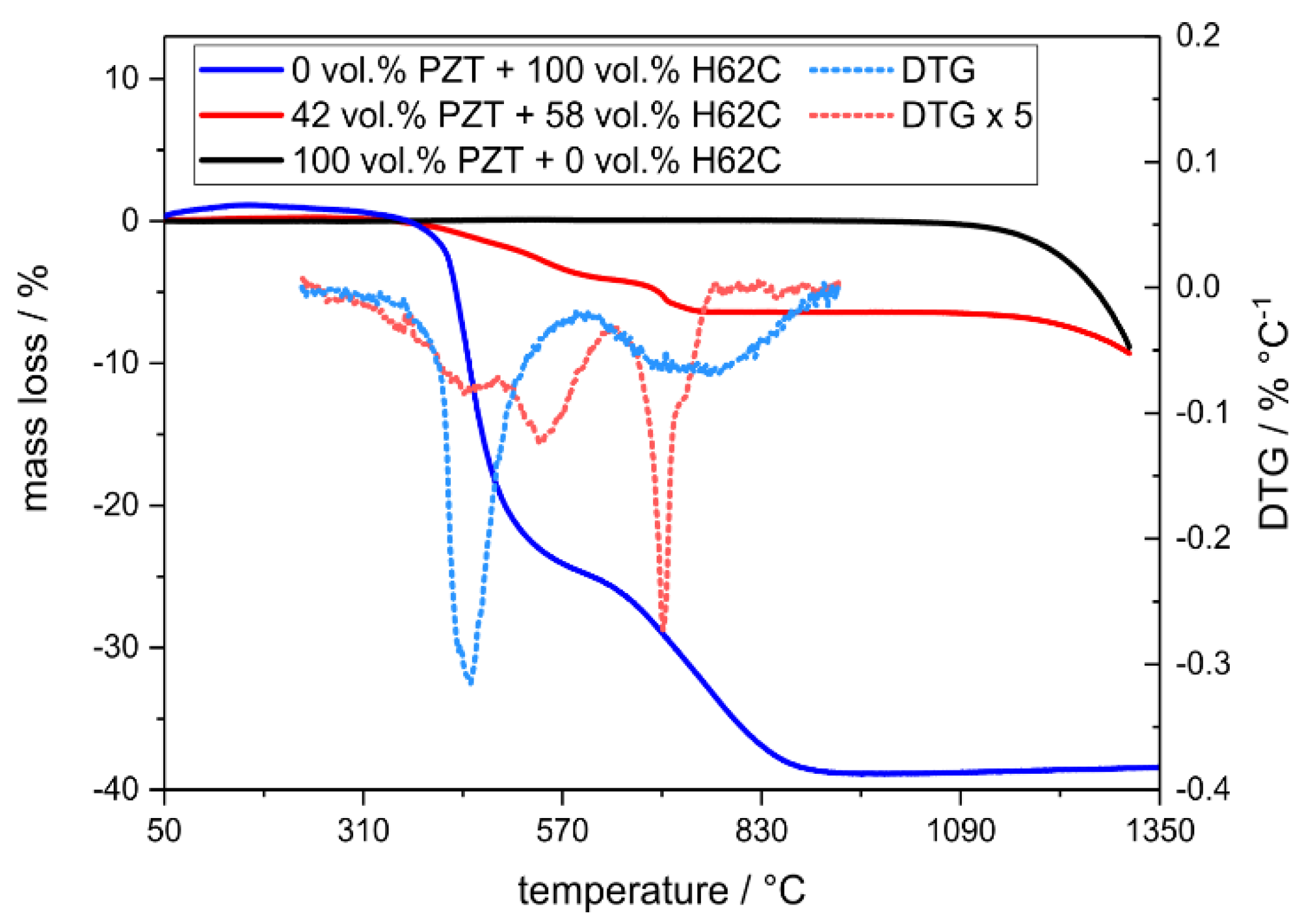
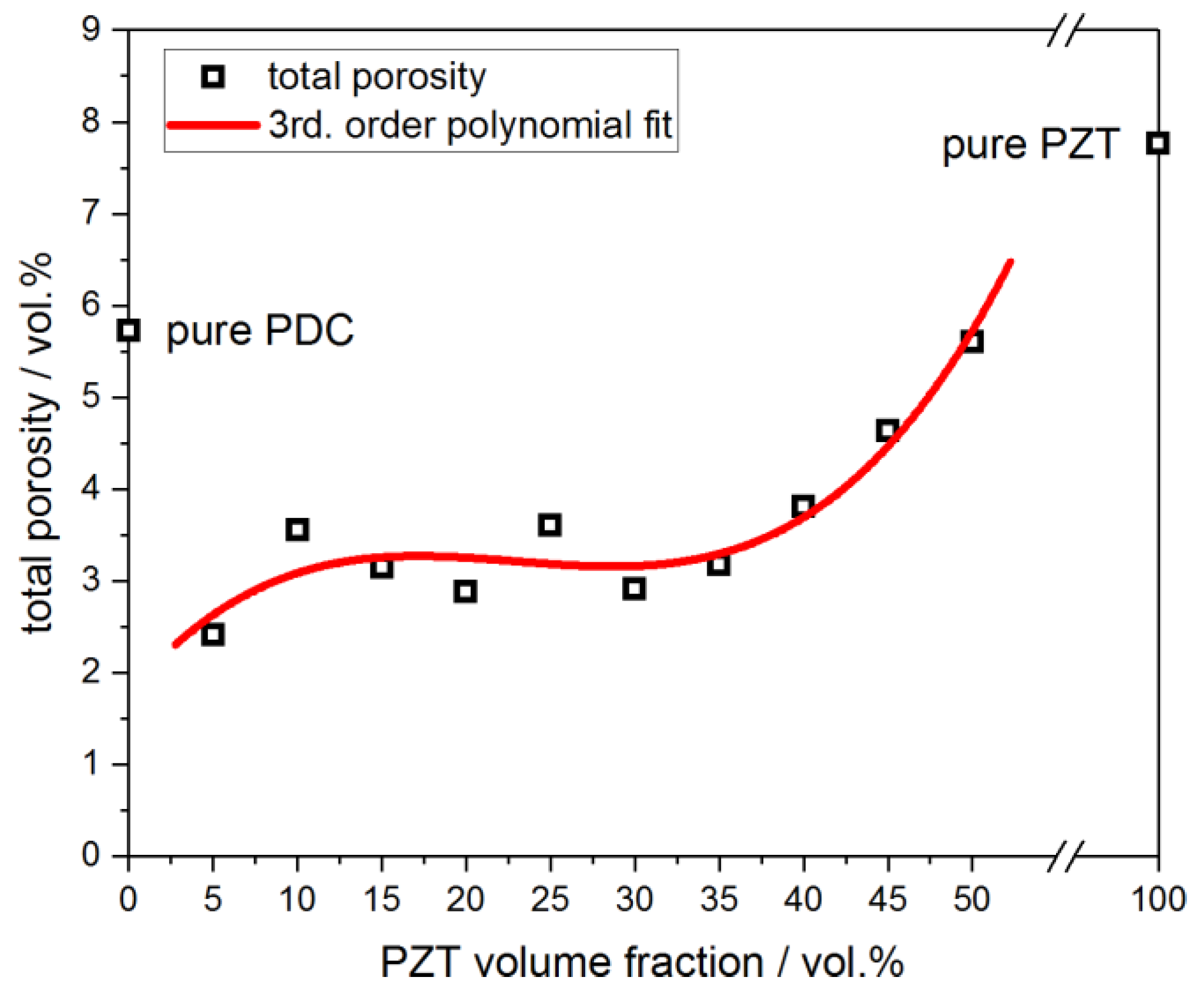
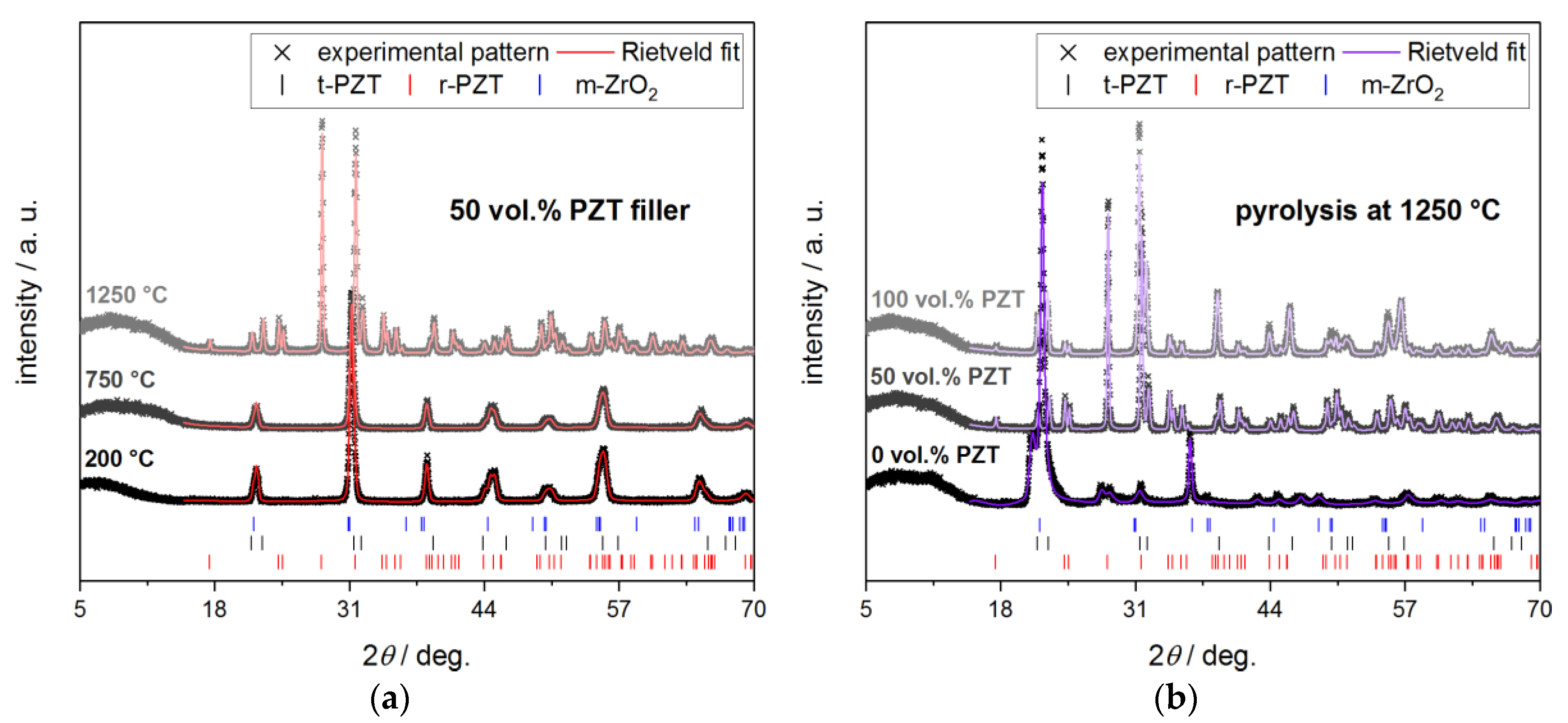
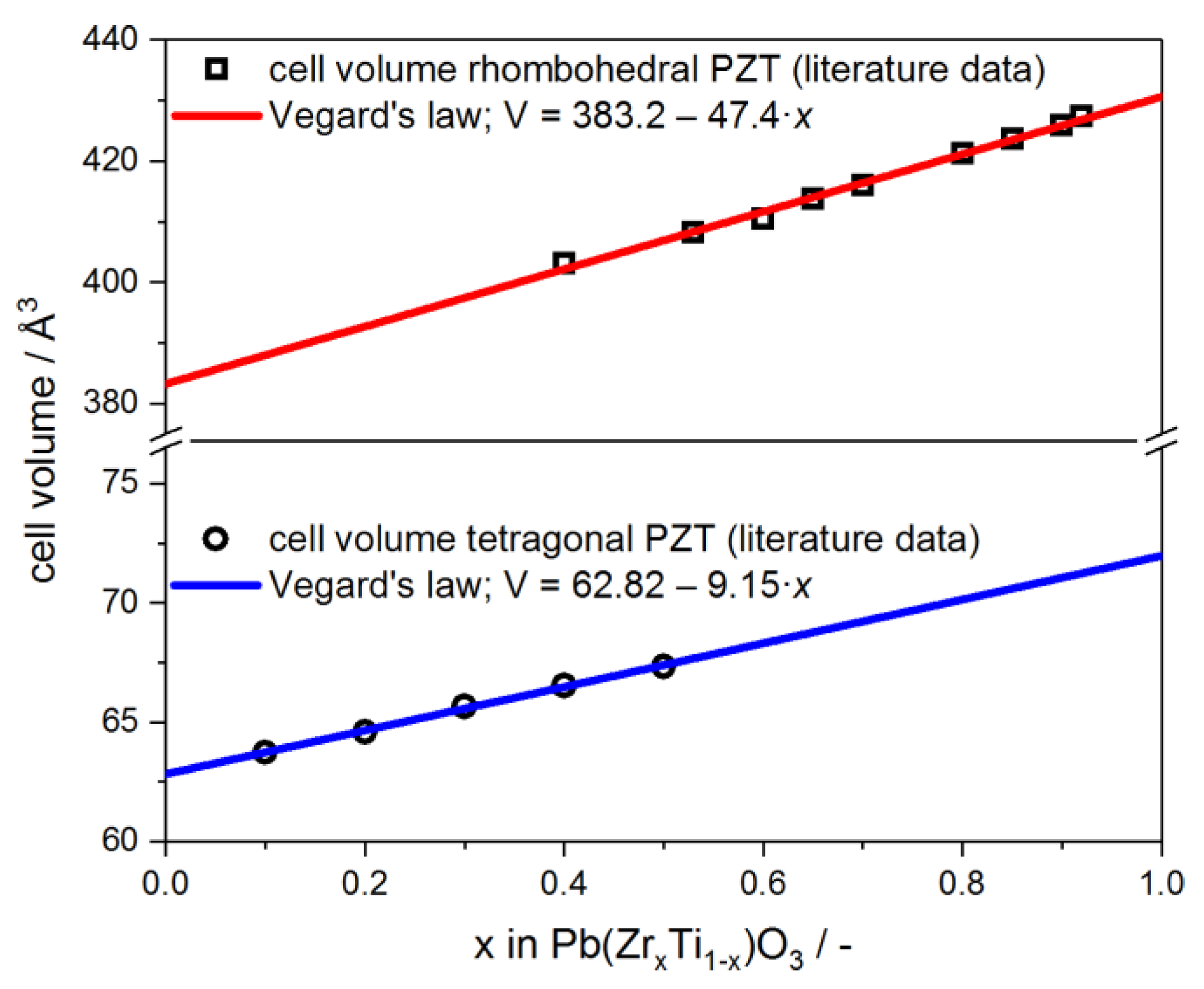
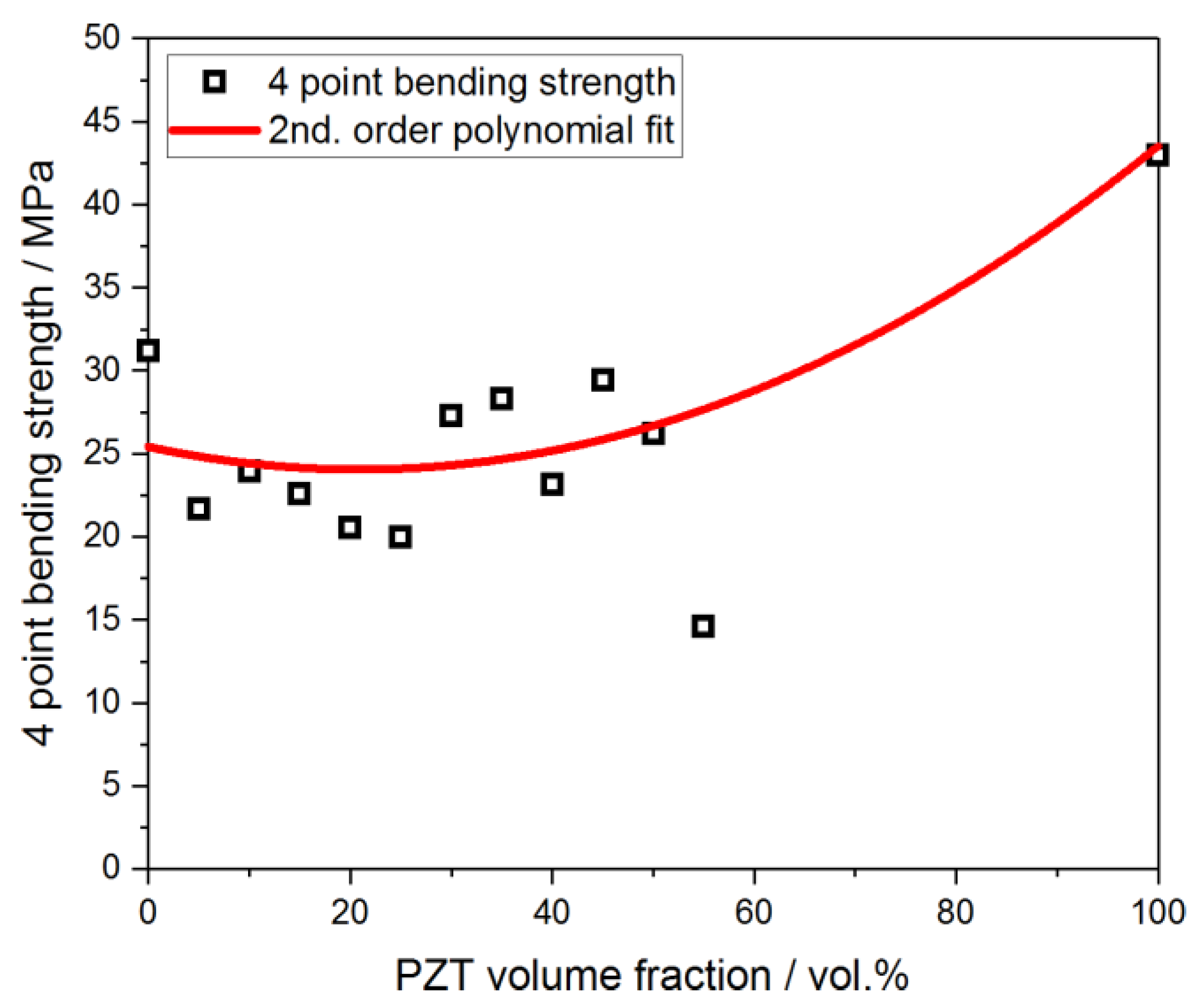
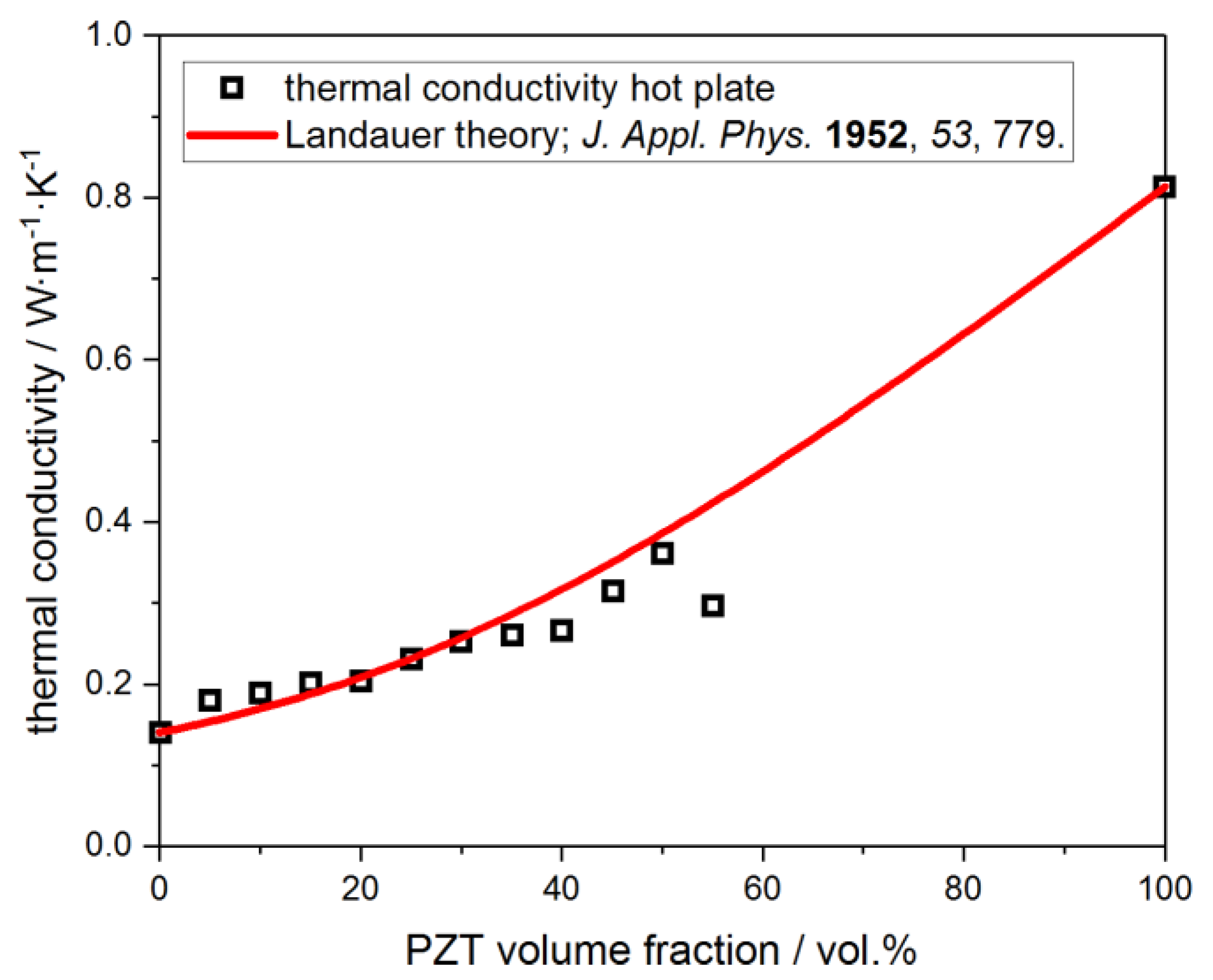
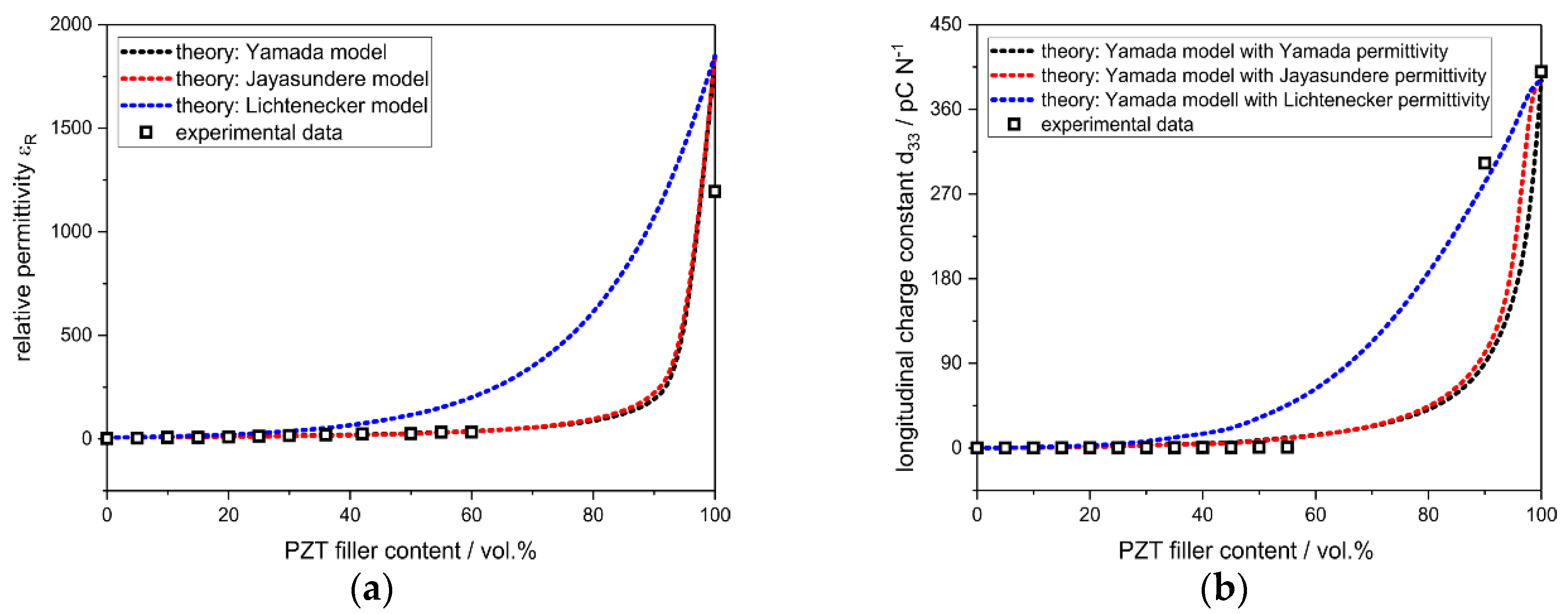
| Sample | Phase Content and Chemical Composition of Pb(ZrxTi1−x)O3 (PZT) Filler | ||||||||
|---|---|---|---|---|---|---|---|---|---|
| filler content/wt.% | pyrolysis T/°C | r-PZT/wt.% | Vr-PZT/Å3 | Zr content x | t-PZT/wt.% | Vt-PZT/Å3 | Zr content x | m-ZrO2/wt.% | cristobalite/wt.% |
| 50 | 200 | 29 ± 1.4 | 408.5 ± 0.2 | 0.534 ± 0.004 | 71 ± 1.4 | 67.60 ± 0.03 | 0.522 ± 0.003 | -/- | -/- |
| 50 | 750 | 34 ± 2.4 | 408.2 ± 0.3 | 0.524 ± 0.007 | 66 ± 2.4 | 67.53 ± 0.04 | 0.515 ± 0.005 | -/- | -/- |
| 50 | 1250 | -/- | -/- | -/- | 19 ± 0.3 | 63.70 ± 0.01 | 0.096 ± 0.001 | 81 ± 0.3 | -/- |
| 50 | 200 | 33 ± 1.0 | 408.2 ± 0.2 | 0.528 ± 0.004 | 67 ± 1.0 | 67.58 ± 0.02 | 0.520 ± 0.002 | -/- | -/- |
| 100 | 200 | 38.7 ± 0.5 | 407.0 ± 0.6 | 0.502 ± 0.013 | 61.3 ± 0.5 | 67.40 ± 0.01 | 0.501 ± 0.001 | -/- | -/- |
| 0 | 1250 | -/- | -/- | -/- | -/- | -/- | -/- | -/- | 100 a |
| 50 | 1250 | -/- | -/- | -/- | 18.1 ± 0.2 | 63.69 ± 0.01 | 0.095 ± 0.001 | 81.9 ± 0.2 | -/- |
| 100 | 1250 | 1.3 ± 0.2 | 385.0 ± 0.5 | 0.02 ± 0.01 | 59.5 ± 0.5 | 64.92 ± 0.01 | 0.229 ± 0.001 | 39.2 ± 0.5 | -/- |
© 2020 by the authors. Licensee MDPI, Basel, Switzerland. This article is an open access article distributed under the terms and conditions of the Creative Commons Attribution (CC BY) license (http://creativecommons.org/licenses/by/4.0/).
Share and Cite
Eichhorn, F.; Kellermann, S.; Betke, U.; Fey, T. Phase Evolution, Filler-Matrix Interactions, and Piezoelectric Properties in Lead Zirconate Titanate (PZT)-Filled Polymer-Derived Ceramics (PDCs). Materials 2020, 13, 1520. https://doi.org/10.3390/ma13071520
Eichhorn F, Kellermann S, Betke U, Fey T. Phase Evolution, Filler-Matrix Interactions, and Piezoelectric Properties in Lead Zirconate Titanate (PZT)-Filled Polymer-Derived Ceramics (PDCs). Materials. 2020; 13(7):1520. https://doi.org/10.3390/ma13071520
Chicago/Turabian StyleEichhorn, Franziska, Simone Kellermann, Ulf Betke, and Tobias Fey. 2020. "Phase Evolution, Filler-Matrix Interactions, and Piezoelectric Properties in Lead Zirconate Titanate (PZT)-Filled Polymer-Derived Ceramics (PDCs)" Materials 13, no. 7: 1520. https://doi.org/10.3390/ma13071520
APA StyleEichhorn, F., Kellermann, S., Betke, U., & Fey, T. (2020). Phase Evolution, Filler-Matrix Interactions, and Piezoelectric Properties in Lead Zirconate Titanate (PZT)-Filled Polymer-Derived Ceramics (PDCs). Materials, 13(7), 1520. https://doi.org/10.3390/ma13071520







